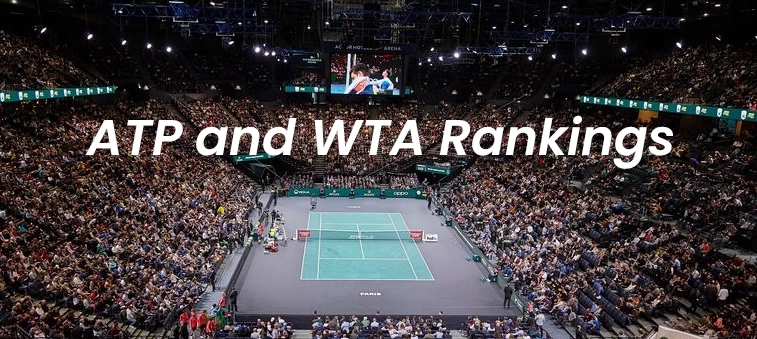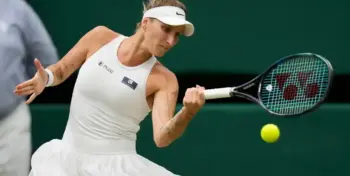Points, race, live ranking & more – Rankings explained
If you’ve ever watched tennis for more than a few minutes, you’ll likely have noticed something: almost every player has a rank. Who gives out these ranks? How do they work? What does a player do to increase or decrease their rank?
As tennisnerds, we want to make it simple to understand for everyone. That’s why we’re digging into the ATP and WTA rankings, and explaining everything you need to know about them.
From how players accrue points, through to protected rankings, the year-end race, and live rankings, we look at all the finer details of the ranking system in men’s and women’s tennis.
What are the PIF ATP/WTA Rankings?
Tennis uses a ranking system where players accrue points based on their performance in events over the past 12 months.
The number of points a player has will influence where they stand in the global rankings, and therefore what their overall ranking is. These rankings are officially known as the PIF ATP Rankings and the PIF WTA Rankings.
Every professional tennis player that has been active in the past 12 months has a rank, made up of the points they’ve accumulated in that time.
How do tennis players earn ranking points?
In short, players earn ranking points in tennis by winning.
All ATP and WTA sanctioned events award points to players for their performance. Points are not just given out for winning a tournament, even qualifying or losing in the first round will earn a player a small number of points.
Here’s a look at some of the points on offer in ATP events:
| Event | Win | Runner up | Semi-finals | Quarter-finals | Round of 16 | Round of 32 | Round of 64 | Round of 128 |
| Grand Slam | 2000 | 1200 | 800 | 400 | 200 | 100 | 50 | 10 |
| Masters | 1000 | 650 | 400 | 200 | 100 | 50 | 30 | 10 |
| ATP 500 | 500 | 330 | 200 | 100 | 50 | 25 | NA | NA |
| ATP 250 | 250 | 165 | 100 | 50 | 25 | NA | NA | NA |
Outside of these larger events, there are also Challenger tournaments and Futures events as well. Of course, the WTA operates a similar model with their events too.
A player’s overall ranking will be the cumulative result of all their performances at events. However, these points only make up their ranking for 12 months, and then they drop off.
In effect, this means that if a player did well at an event last year, they’ll need to do well again the next year. Do so, and they’ll keep their ranking points; fail to, and the points will drop off, impacting their ranking.
What is the purpose of having ranking points in tennis?
Why have ranking points in the first place? The primary reason is for something called ‘seeding’.
In layman’s terms, seeding is the process of sorting out who the best players are in any given tennis tournament, and making sure they don’t play each other until later on in the event.
For example, in a WTA 250 event, you might have the world No 4 and the world No 9 participating. It doesn’t make sense for these two to meet in the first round of the tournament. They’re the two best players in the event, so they should meet in the final.
With seeding, those two players would be given the No 1 and No 2 seeds. This would mean they’d end up on opposite sides of the draw and not play until the final.
If they didn’t receive seeding, it would be pure luck who played who. This would impact the integrity of a competition, as players of lesser ability could make it far, simply because of luck, rather than skill.
Outside of seeding, the ATP and WTA ranking systems are also used for determining entry to events. Not just anyone can make the cut to play in a professional tournament. Only a certain number qualify, and this is based on a player’s ranking.
How does live ranking work in tennis?
You might have heard a player’s “live ranking” mentioned in relation to tennis, not just their official ranking.
The way the ATP and WTA rankings work is that each Monday the overall rankings are updated. This is because the large majority of tennis tournaments conclude on a Sunday, making Monday a natural point to record each player’s performance.
However, throughout the course of a week, before the official rankings have been updated, a player’s live ranking can be used to track how they’re doing as well.
For example, a player might have made the quarter-finals of a Grand Slam last year. This season, when they play that same Grand Slam, they’ll drop 400 points. This will cause their live ranking to drop. However, if they make a deep run and go all the way to the final, their live ranking will increase with the 1200 additional points they’ve earned.
Live rankings are simply a way of having a sneak peak at what the official rankings will look like when they’re released the following Monday.
What is the Race to Turin?
Another phrase you might have heard tossed around is “The Race to Turin” or just “The Race”.
What this is referring to is simply how players are performing in the calendar year.
While a player’s ATP or WTA ranking refers to their performance over the last 12 months, The Race solely tracks how they’ve performed this season.
For example, Novak Djokovic is ranked No 3 in the ATP Rankings, compared to Alex de Minaur who sits at No 9. However, De Minaur has had a better season than Djokovic over the first half of 2024. As a result, the Australian sits at No 7 in the Race to Turin, while Djokovic is back at No 10.
Early on in a season, The Race can vary a lot from the actual rankings. However, as the season gets closer to its end, The Race and the official rankings become more and more similar.
The purpose of The Race is to determine which eight players will compete in the year-end championships.
These are held as the final event of the season for both the ATP and WTA Tours. Both events consist of the seven players that have the most points in The Race, plus any Grand Slam winner sitting between No 8 to No 20 in The Race.
What happens if a player is injured and can’t play?
Injuries happen in tennis. What occurs to a player’s ranking if they aren’t able to play for an extended period of time?
Both Tours offer something called a “protected ranking”.
This can be applied for if a player is injured for six months or more, and wants to gain direct entry into tournaments they previously would have been eligible for. There are a few stipulations around how this ranking is calculated and how long it can be used for.
In essence, a protected ranking gives players a decent shot at proving they’re still capable of playing at their pre-injury level.
Players still need to earn back all of their ranking points. However, they get a hand up in doing so. Rather than having to work their way through smaller events over the course of years to build their points back up, opportunity is given to accrue points faster by contesting the bigger tournaments.















